Exploring Green Worms: Impact and Management Strategies
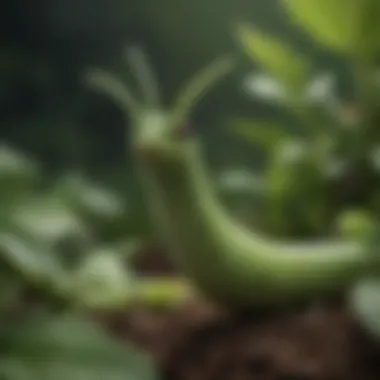
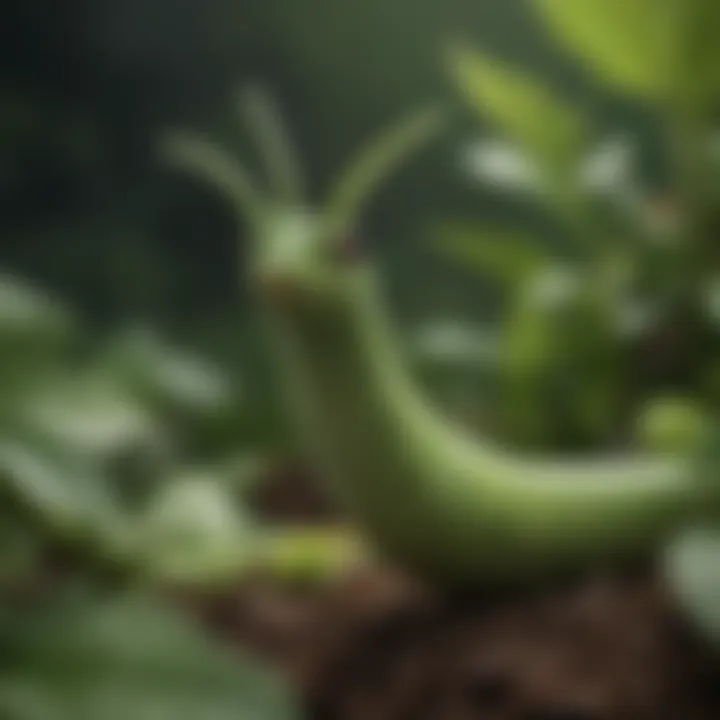
Intro
Green worms, often overlooked in the realm of garden management, play a unique role that blends benefits and challenges for gardeners. These creatures, which are often identified as caterpillars or larvae, serve as both beneficial allies and unwanted pests. Understanding their ecological significance, especially in sustainable gardening, is essential for maximizing garden health while minimizing potential damage to plants.
This article provides an in-depth overview of green worms, examining their various types and the intricate relationship they maintain with garden ecosystems. By exploring their life cycles and interactions with plants, we aim to present readers with practical strategies for managing these organisms in their gardens effectively.
Topic Overview
Definition and Importance
Green worms are typically the larvae of moths and butterflies, which can have significant implications for your garden. They often consume foliage, but their presence can indicate a healthy ecosystem that supports biodiversity. Healthy populations can contribute to soil regeneration through their waste. In addition, they can act as food sources for a variety of wildlife such as birds and beneficial insects.
Brief History and Evolution
Historically, gardeners have viewed green worms with a mixture of admiration and trepidation. Their role in ecosystems has been documented for centuries, often recognized as both a natural pest and a vital part of food webs. Some species have evolved to be more resilient and adaptable to changing environments, leading to shifts in their population dynamics and their relationships with garden plants.
Key Techniques and Innovations
Sustainable Farming Practices
Adopting sustainable gardening methods can help manage green worms more effectively. Integrated pest management strategies may involve the use of natural predators like birds or beneficial insects, such as ladybugs. Cultivating plants that attract beneficial organisms can help control green worm populations.
- Utilize companion planting
- Establish habitats for natural predators
- Monitor plant health regularly
Advanced Agronomic Technologies
Recent advancements in agronomy provide gardeners with tools for monitoring and controlling pest populations, including the use of pheromone traps or organic insecticides. These methods reduce reliance on synthetic chemicals and promote a balanced ecosystem.
Practical Applications
Step-by-Step Guides
To manage green worms, gardeners can follow these steps:
- Identify the type of green worm present.
- Assess the level of damage to your plants.
- Choose an appropriate management strategy—whether it’s hand-picking, introducing predators, or applying organic controls.
- Monitor the garden regularly to prevent reoccurrence.
Case Studies or Real-World Examples
There are numerous instances where gardeners have successfully integrated green worms into their ecosystem management plans. A community garden in California used sustainable practices and reported an increase in biodiversity while keeping tomato plants healthy despite some green worm presence.
"Embracing green worms in your garden can create a more diversified ecosystem that benefits not just your plants, but the environment overall."
Preamble to Green Worms
The examination of green worms is vital for understanding their influence in garden ecosystems. These creatures often go unnoticed, yet they play significant roles in maintaining ecological balance. Recognizing both their benefits and potential challenges can help gardeners make informed decisions. This introduction lays the groundwork for appreciating the complexity of these organisms and sets the tone for in-depth discussions on their impact in gardens.
Defining Green Worms
Green worms refer to several species within the larval stage of insects, primarily moths and butterflies. Their appearance varies, but most share a greenish hue, allowing them to blend into the vegetation. Green worms thrive in diverse habitats, but they are especially prevalent in gardens abundant with foliage. It's imperative to grasp their significance in the lifecycle of the garden. These larvae can influence both plant health and the overall ecosystem.
Common Species Found in Gardens
Several common species of green worms can be found in gardens. Understanding these species helps in identifying their effects on plants:
- Cabbage Looper (Trichoplusia ni):
A notable pest for cruciferous crops such as cabbage and broccoli. Its characteristic looping movement can be observed during feeding. - Fall Armyworm (Spodoptera frugiperda):
This species is known for its aggressive feeding habits. It targets a wide range of plant varieties, posing a risk for many gardeners. - Cutworm (Agrotis spp.):
These larvae often feed at night, damaging plants at their base. Different species can cause varying levels of harm.
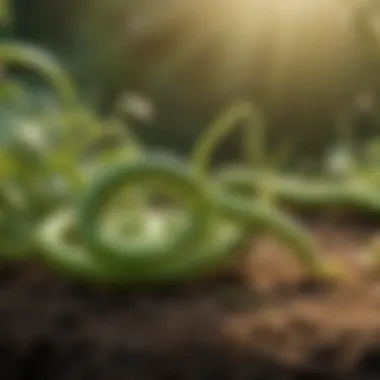

Understanding these species is crucial for gardeners to prepare and respond effectively. Each species poses unique challenges but also contributes to the ecosystem in different ways.
The presence of green worms in gardens necessitates careful observation and management strategies to protect plant health while promoting biodiversity.
The Ecological Role of Green Worms
Green worms play a significant role in garden ecosystems that many gardeners may overlook. Their presence can positively influence soil health and the overall environment of a garden. Understanding the ecological implications of these worms is crucial for gardeners aiming to foster a vibrant ecosystem. The interactions these worms have with soil and other creatures are essential for promoting sustainability within the gardening practice.
Contributors to Soil Health
Decomposition Processes
Decomposition processes carried out by green worms are vital for soil enrichment. As these worms consume organic matter, they break it down into simpler substances. This natural recycling is beneficial because it enhances soil structure and increases its nutrient content. The key characteristic of green worms in this context is their ability to transform waste into fertile soil. This makes them essential in maintaining a healthy garden environment. While the decomposition they facilitate is largely advantageous, there are instances where excessive worm populations can lead to imbalances in the ecosystem.
Nutrient Recycling
The process of nutrient recycling is another important aspect of green worms' role in gardens. By breaking down organic material, these worms help release nutrients back into the soil, making them available for plant roots. Nutrient recycling contributes to a balanced nutrition cycle that supports plant growth. Furthermore, the unique feature of nutrient recycling is how it can improve soil fertility over time, providing sustained benefits for various crops. However, it is critical to monitor nutrient levels, as an excess in certain minerals can create challenges for specific plants.
Interactions with Other Garden Inhabitants
Beneficial Insects
Green worms often interact with beneficial insects, forming a complex web of relationships in the garden ecosystem. Beneficial insects, like ladybugs and lacewings, often help control pest populations, which can thrive if green worms are left unchecked. The key element here is that the presence of these worms can signal to other beneficial organisms that the environment is supportive for life. This symbiotic relationship contributes to a more balanced ecosystem. However, reliance solely on these interactions may not be enough; active management is often necessary to ensure a healthy balance.
Predatory Relationships
The predatory relationships involving green worms also play a critical role in maintaining population control. Birds, for instance, often feed on worms, creating a natural check on their numbers. The main characteristic of this relationship is how it reinforces the food chain dynamics. An imbalance, with too many worms, can lead to over-consumption of plants, while too many predators can starve worm populations. Thus, observing these relationships closely helps gardeners maintain their desired balance in the ecosystem.
Identifying Green Worm Species
Identifying green worm species is essential for any gardener looking to maintain a healthy ecosystem. Understanding the different types of green worms can inform decisions on pest control and ecosystem management. Some green worms contribute positively to soil health and plant growth, while others may damage crops. Knowledge about worm species can help in balancing these benefits and challenges.
Characteristics of Common Green Worms
Color Variations
Color variations among green worms often serve as an initial identification tool. Most green worms have shades of green, but they can also appear in brown or even striped patterns. This diversity in color is a key characteristic that helps gardeners recognize the species present in their gardens. Some species known for their distinct coloration are more beneficial than others. Therefore, understanding these color differences aids in distinguishing helpful worms from pests. The unique feature of color variations can give clues about the specific type of worm, influencing gardener decisions on management strategies.
Size Differences
Size differences can significantly impact both the role and appearance of green worms in gardens. Typically, these worms can vary in length from a few centimeters to several inches. For instance, larger green worms are often seen as more threatening to garden plants due to their ability to consume larger quantities of foliage. Recognizing these size variations enables gardeners to tailor their response according to the potential risk a worm species may pose to crops. The advantages of recognizing size differences lie in quicker identification of pests and more focused management practices.
Body Structure
The body structure of green worms provides insights into their behavior and lifestyle. Many worms have a simplified cylindrical body, while some exhibit unique features like segmented bodies or specialized appendages. Understanding these structural characteristics can help in identifying their feeding habits and roles within the garden’s ecosystem. For example, certain body structures may suggest a worm is a specialist feeder or a generalist that damages multiple plant types. Ultimately, recognizing the body structure contributes to forming a comprehensive view of green worms' ecological roles.
Distinguishing Between Beneficial and Harmful Species
Identifying whether a green worm is beneficial or harmful is crucial to effective garden management. By leveraging specific identifying factors, gardeners can avoid unnecessary interventions and promote a thriving environment.
Non-pest Identification
Non-pest identification focuses on determining which worms are safe and may provide benefits to the garden. Many green worms aid in soil aeration and nutrient cycling. They often indicate a healthy ecosystem in which they thrive. Recognizing these non-pest species cultivates a more favorable view towards these organisms. This knowledge helps gardeners differentiate between potential pests and invaluable allies in the ecosystem.
Pest Diagnostics
Pest diagnostics is critical to ensuring that gardeners can respond adequately when harmful worm species are identified. Certain green worms may exhibit behavior, such as excessive leaf consumption or surface feeding, that signals a problem. Accurate pest diagnostics involves observing their behaviors and identifying the symptoms they cause in plants. This specificity allows for targeted interventions, reducing damage while preserving beneficial species. Being adept at pest diagnostics stands as a pillar of integrated pest management strategies.


The Impact of Green Worms on Garden Plants
Understanding the impact of green worms on garden plants is essential for effective gardening practices. These organisms contribute both positively and negatively to plant development. This section addresses the dual nature of green worms, focusing on their benefits as well as the potential challenges they present. Recognizing these aspects can help gardeners make informed decisions about managing their presence in the garden.
Positive Effects on Plant Development
Green worms can greatly benefit plant growth and development. Their activities support a variety of ecological functions that promote a healthy garden environment. Here are several ways in which they contribute positively:
- Soil Aeration: Green worms burrow through the soil, creating channels that facilitate air and water infiltration. This aeration improves root access to essential nutrients and moisture.
- Nutrient Enrichment: As green worms feed on plant debris and organic matter, they break it down, enhancing nutrient availability in the soil. Their waste, often rich in nitrogen, serves as a natural fertilizer that boosts plant vitality.
- Enhancing Decomposition: The presence of green worms accelerates decomposition processes. This breakdown of organic materials contributes to the formation of rich humus, which is vital for soil health.
By supporting these ecological functions, green worms can significantly improve overall plant development. It's key to observe the conditions in the garden to leverage these beneficial impacts effectively.
Potential Risks and Damage to Crops
Despite their positive effects, green worms can pose significant risks to crops. Certain species are known to be pests that can lead to plant damage. Understanding these potential issues is crucial for gardeners to minimize risks. The following points highlight some of the challenges associated with green worms:
- Feeding Damage: Some green worms can feed on plant foliage, leading to visible damage. This can reduce a plant's ability to photosynthesize, ultimately affecting growth and yield.
- Crop Infestations: Under certain conditions, green worms can multiply rapidly, causing infestations. High populations can result in extensive damage across a variety of crops, which may require intervention measures.
- Pest Behavior: Certain species may exhibit aggressive feeding habits, leading to their classification as pests. It is important to differentiate between beneficial and harmful green worm species to mitigate crop damage effectively.
Management Strategies for Green Worms
Effective management of green worms is critical in maintaining a harmonious garden environment. These strategies ensure that gardeners can benefit from the positive impacts of green worms while minimizing any potential harm they might cause to crops. Through a careful balance of natural controls, cultural practices, and judicious use of chemical options, gardeners can foster a healthier ecosystem. Consideration of local biodiversity and soil health is essential. Management plans should be tailored to specific conditions and crop types, promoting resilience against both pests and environmental stressors.
Natural Control Methods
Encouraging Natural Predators
Encouraging natural predators is an essential aspect in managing green worms. This method introduces or protects the species that can naturally keep green worm populations in check. Ladybugs, lacewings, and certain birds are known to actively hunt and consume green worms. By creating a habitat that attracts these beneficial creatures, gardeners can achieve pest control without chemical interventions.
A key characteristic of this method is its sustainability. Unlike pesticides, natural predators do not harm the ecosystem. Instead, they provide ongoing protection, which means a gardener does not need to continuously apply or monitor the situation.
However, one unique feature to consider is the time it takes for predators to establish themselves in the garden. Some gardeners might find it challenging to attract these beneficial species, especially in urban environments where habitats are limited. Nevertheless, once established, they can provide significant long-term benefits to garden health.
Creating a Balanced Ecosystem
Creating a balanced ecosystem contributes significantly to the overall health of the garden. A diverse array of plants, insects, and microbial life can help mitigate pest issues, including those related to green worms. By planting a variety of crops and using companion planting techniques, gardeners can support a richer food web.
This diversity is beneficial as it encourages pest control through various biological mechanisms. For instance, certain plants can repel pests or attract predatory insects that feed on green worms. The unique feature is that a balanced ecosystem can self-regulate, reducing the need for constant intervention from gardeners.
However, achieving balance requires careful planning and understanding of the local environment. There is a risk that unplanned introductions of new species could disrupt existing ecosystems. Monitoring and observation are essential to ensure that the desired balance is maintained.
Cultural Practices
Crop Rotation
Crop rotation remains a fundamental strategy for managing green worms. By changing crop types in a specific area of the garden over time, gardeners can disrupt the life cycle of green worms that may have established a presence. Each plant type has its own vulnerabilities and attracting specific pests, thus rotating crops helps in minimizing herbivore pressure.
This method is popular and beneficial since it not just aids in pest management but also enhances soil fertility. Different plants contribute varying nutrients, and rotating them can prevent nutrient depletion from the soil. Careful planning is required to ensure that the cycle accommodates the gardener's goals and minimizes disruption to farm operations.
However, a consideration is the need for planning and record-keeping. Gardeners must maintain awareness of which crops were planted where and when. This can require additional effort and expertise, especially in large gardens.
Proper Watering Techniques
Proper watering techniques play a vital role in managing green worms. Overwatering can lead to lush foliage, which may attract more pests, whereas underwatering can stress plants and make them more vulnerable to infestations. Therefore, establishing a watering schedule based on plant needs is essential.
This technique is beneficial since it promotes plant health overall, leading to stronger resistance against pests and diseases. Implementing drip irrigation or soaker hoses can minimize water waste while ensuring that plants receive necessary hydration.
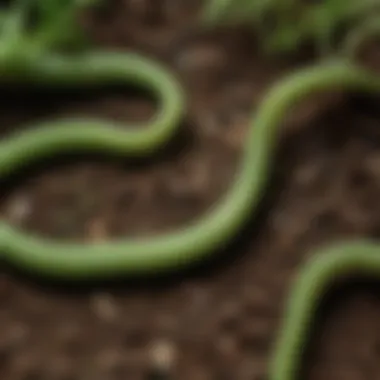
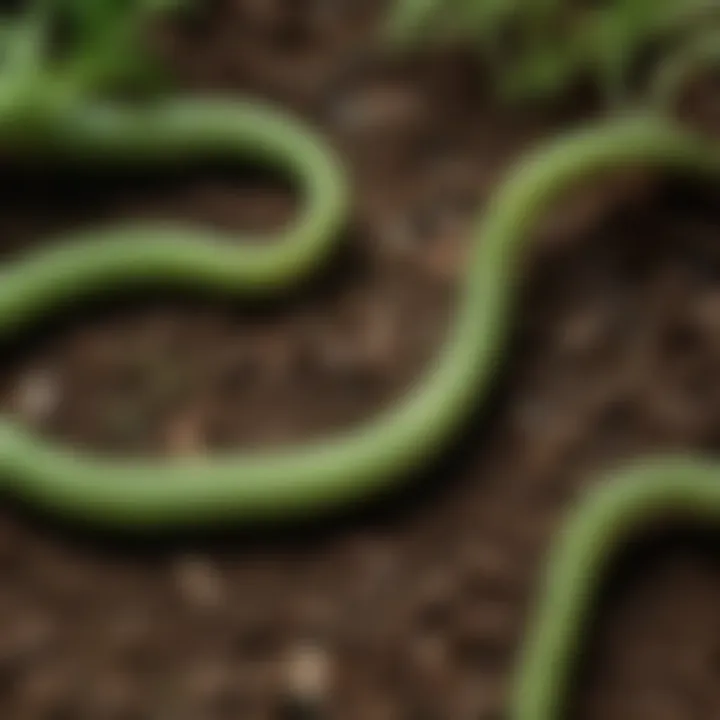
One unique aspect of proper watering is its influence on soil structure. Well-watered soil maintains better aeration and biology. However, care must be taken not to create overly damp environments, which can lead to fungal diseases that may further complicate pest management. Balancing moisture levels is crucial for garden health.
Chemical Control Options
Herbicides and Pesticides
While many prefer natural methods, herbicides and pesticides can be part of integrated management strategies. These chemicals can quickly reduce green worm populations and provide immediate relief from infestations. However, they should be used judiciously, as improper application can lead to negative effects on non-target species and the environment.
The effectiveness of these chemicals is a key characteristic. Certain formulations can target specific types of pests with minimal risk to beneficial insects. However, acknowledgement of potential downsides is critical, such as developing resistance and the possibility of impacting beneficial insect populations.
One unique feature of chemical controls is that they can act quickly, providing noticeable results within days. However, reliance on these chemicals can foster dependencies and reduce the natural ecosystem's resilience. Careful consideration should be taken before opting for this approach.
Application Guidelines
Application guidelines are vital for ensuring effective and safe use of herbicides and pesticides. These guidelines provide instructions on dosage, timing, and method of application to minimize damage to the garden ecosystem. Following these guidelines can assist in maximizing benefits while mitigating negative effects.
A critical point is the importance of timing. Applying chemicals too early or too late can result in ineffective pest control and harm beneficial species. This feature enhances the potential for successful pest management when adhered to strictly.
However, the guidelines can be complicated, especially for novice gardeners. There is a learning curve involved in understanding when and how to apply treatments. It requires vigilance and patience, emphasizing the need for ongoing education in responsible gardening practices.
Sustainable Practices in Managing Green Worms
Sustainable practices play a vital role in managing green worms within garden ecosystems. As gardeners strive for environmental balance, incorporating these methods can lead to healthier plants and a more productive garden environment. Understanding how sustainable practices work is essential for both novice and experienced gardeners. These methods not only mitigate the challenges posed by green worms but also harness their positive contributions to soil health.
Organic Gardening Techniques
Organic gardening techniques emphasize the use of natural processes to manage green worms effectively. Utilizing organic methods minimizes chemical exposure, protecting both the environment and beneficial garden organisms. One approach is to enhance the diversity of plant species in the garden. This diversity can introduce natural deterrents to harmful worm populations while promoting ecosystems where beneficial species can thrive.
Another technique is focusing on soil health. Healthy soil supports the microbial life necessary for nutrient cycling. Adding organic matter such as compost can help in fostering beneficial organisms that compete with harmful pests. Finally, regularly rotating crops can disrupt the life cycles of green worms, limiting their ability to reproduce and establish in one area.
Integrated Pest Management Approaches
Integrated Pest Management (IPM) provides a comprehensive strategy for managing green worms sustainably. This method combines multiple tactics, analyzing the specific circumstances of the garden and addressing pest issues holistically. Firstly, monitoring and identifying green worm populations allow gardeners to determine the best course of action. Using traps or observing plant damage can assist in making informed decisions.
Secondly, employing biological control measures can significantly reduce the impact of harmful green worms. Encouraging predators, such as birds or beneficial insects, will create a balanced ecosystem that can control worm populations naturally. This approach reduces reliance on synthetic pesticides and fosters a healthier environment.
Lastly, education is crucial in IPM. Educating gardeners about seasonal patterns and the ecological role of green worms helps adjust practices accordingly. Understanding the role of these worms can lead to better decisions that favor plant health while managing worm populations effectively.
Sustainable practices not only ensure the persistence of beneficial garden organisms but also create an environment where plants can flourish.
In summary, adopting sustainable practices in managing green worms fosters a healthier ecosystem. Organic gardening techniques and integrated pest management approaches offer targeted methods to minimize negative impacts while promoting the benefits of green worms in gardens.
End: Balancing Worm Presence and Garden Health
Green worms play an increasingly vital role in garden ecosystems. Understanding how to balance their presence is essential for maintaining overall garden health. Although they can contribute positively to soil quality and plant nutrition, there are also challenges that may arise, including potential crop damage. To navigate this complexity, gardeners should be aware of greener methods and strategies that can help coexist with these creatures.
The key to harmonious garden management lies in recognizing the dual nature of green worms. They can enhance soil quality through their decomposition processes, breaking down organic matter and enriching nutrient cycles. Nonetheless, certain species may pose a threat to plant health. Therefore, careful identification and ongoing monitoring become crucial tasks for any gardener.
Adopting sustainable practices integrates various management strategies. Utilizing natural predators, implementing crop rotation, and embracing organic gardening techniques provides a way to control harmful species without resorting to harmful chemicals. This balance leads to healthier plants and promotes a vibrant ecosystem within the garden environment.
"A proactive approach in managing green worms can lead to a thriving garden that benefits from the unique contributions of these creatures."
In summary, balancing the presence of green worms in the garden is an ongoing process. It requires attention to detail, a commitment to sustainability, and the willingness to adapt to the ecosystem's needs.
Summary of Key Takeaways
- Green worms contribute significantly to soil health through decomposition and nutrient recycling.
- Not all green worms are beneficial; some can damage crops, requiring proper identification.
- A variety of management strategies exist to promote a balanced ecosystem while minimizing harm to plants.
- Sustainable practices are effective in controlling green worm populations, fostering natural relationships.
Future Considerations for Gardeners
As the role of green worms in gardens continues to evolve, gardeners must stay informed about emerging research and trends in sustainable practices. Future considerations may include:
- Advancements in Integrated Pest Management: Keeping up with new methods can enhance control over harmful species while protecting beneficial ones.
- Community Involvement: Engaging with local gardening groups on platforms like Reddit can provide valuable insights and shared experiences.
- Continued Education: Resources such as Wikipedia or Britannica offer an array of information on plant care and pest management strategies.



